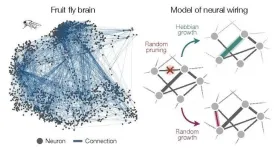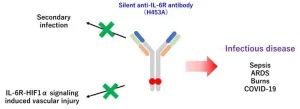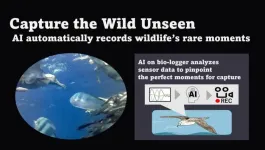(Press-News.org) New York, January 17, 2024 — In all species, brain function relies on an intricate network of connections that allows neurons to send information back and forth between one another, commanding thought and physical activity. But within those networks a small number of neurons share much stronger connections to one another than all the others. These abnormally strong connections—known as “heavy tailed” based on the shape of their distribution—are thought to play an outsized role in brain function.
Researchers have long wondered how neural networks are able to rearrange to form these rare connections and whether the formation process is species specific or governed by a deeper shared principle. With the publication of a new paper in the journal Nature Physics, scientists at the CUNY Graduate Center Initiative for the Theoretical Sciences (ITS), Yale, University of Chicago, and Harvard are getting closer to answering these questions.
“To understand these very strong connections between neurons, you can think of a social network: Some connections, like those with your best friends and family, are much stronger than most, and these are very important in the network,” explains Christopher Lynn, the paper’s first author, previously a postdoctoral fellow with the ITS program and now an Assistant Professor of Physics at Yale. “Until recently, we didn’t have a way of teasing out the mechanism by which these rare connections come together, but advances in particular forms of microscopy and imaging now allow us to take a peek into how it happens.”
The researchers analyzed large, openly available datasets of the wiring between neurons in fruit flies, mice and two worm species (C. elegans and Platynereis). The catalogued data, which was collected using volume electron microscopy and high-throughput image processing, allowed them to compare networks across multiple species, looking for similarities and differences in the way heavy tailed connections form.
The scientists created a mathematical model to describe how they believed wiring between neurons can rearrange to develop these strong connections. This model was based on a decades-old mechanism from neuroscience known as Hebbian plasticity, which says when neurons fire together, they wire together. The researchers showed that this Hebbian plasticity leads neurons to form the types of heavy tailed connections they observed in the data. What’s more, when they included neural activity in the model, a second key feature of neural network structure emerged: clustering, or the tendency for neurons to form tightly knit groups.
“Our model was based on the assumption that neurons rearrange and connect under a mixture of Hebbian and random dynamics,” said Lynn, noting that neurons sometimes connect for specific reasons, but other times randomly. The research team’s model proved applicable across species, showing how simple and general principles of cellular self-organization can lead to the very strong connections and tightly connected networks that exist in the brain. The findings suggest that neuronal network formation isn’t dependent on species-specific mechanisms, but instead might be governed by a simple principle of self-organization. This new knowledge could provide an important foundation for investigating brain structure in other animals and may even help to better understand human brain function.
About the Graduate Center of The City University of New York
The CUNY Graduate Center is a leader in public graduate education devoted to enhancing the public good through pioneering research, serious learning, and reasoned debate. The Graduate Center offers ambitious students nearly 50 doctoral and master’s programs of the highest caliber, taught by top faculty from throughout CUNY — the nation’s largest urban public university. Through its nearly 40 centers, institutes, initiatives, and the Advanced Science Research Center, the Graduate Center influences public policy and discourse and shapes innovation. The Graduate Center’s extensive public programs make it a home for culture and conversation.
END
Fly brain, mouse brain, worm brain: They all network the same
A new study suggests different species may rely on a shared principle for neural network formation.
2024-01-17
ELSE PRESS RELEASES FROM THIS DATE:
Surprisingly simple model explains how brain cells organize and connect
2024-01-17
A new study by physicists and neuroscientists from the University of Chicago, Harvard and Yale describes how connectivity among neurons comes about through general principles of networking and self-organization, rather than the biological features of an individual organism.
The research, published on January 17, 2024 in Nature Physics, accurately describes neuronal connectivity in a variety of model organisms and could apply to non-biological networks like social interactions as well.
“When you’re building simple models to ...
Transforming clinical recording of deep brain activity with a new take on sensor manufacturing
2024-01-17
Sensors built with a new manufacturing approach are capable of recording activity deep within the brain from large populations of individual neurons–with a resolution of as few as one or two neurons–in humans as well as a range of animal models, according to a study published in the Jan. 17, 2024 issue of the journal Nature Communications. The research team is led by the Integrated Electronics and Biointerfaces Laboratory (IEBL) at the University of California San Diego.
The approach is unique in several ways. It relies on ultra-thin, flexible and customizable probes, made of clinical-grade materials, and equipped with sensors that can record extremely localized ...
Role of inherited genetic variants in rare blood cancer uncovered
2024-01-17
Large-scale genetic analysis has helped researchers uncover the interplay between cancer-driving genetic mutations and inherited genetic variants in a rare type of blood cancer.
Researchers from the Wellcome Sanger Institute, the University of Cambridge, and collaborators, combined various comprehensive data sets to understand the impact of both cancer-driving spontaneous mutations and inherited genetic variation on the risk of developing myeloproliferative neoplasms (MPN).
The study, published today (17 January) in Nature Genetics, describes how inherited genetic variants can influence whether a spontaneous mutation in a particular ...
AI model predicts death, complications for patients undergoing angioplasty, stents
2024-01-17
When a person has one or more blocked arteries, providers may choose to conduct a minimally invasive procedure known as percutaneous coronary intervention, or PCI.
By inflating a balloon and potentially placing a stent, blood can flow more freely from the heart.
Despite carrying less risk than open surgery, stenting and balloon angioplasty can result in complications like bleeding and kidney injury.
Researchers at Michigan Medicine developed an AI-driven algorithm that accurately predicts death and complications after PCI — which could emerge as a tool ...
E-cigarettes help pregnant smokers quit without risks to pregnancy
2024-01-17
A new analysis of trial data on pregnant smokers, led by researchers at Queen Mary University of London, finds that the regular use of nicotine replacement products during pregnancy is not associated with adverse pregnancy events or poor pregnancy outcomes.
The PREP 2 study used data collected from over 1100 pregnant smokers attending 23 hospitals in England and 1 stop-smoking service in Scotland to compare pregnancy outcomes in women who did or did not use nicotine in the form of e-cigarettes (EC) or nicotine patches ...
John Innes Centre researcher honored with prestigious Blavatnik award
2024-01-17
The pioneering research of Dr Yiliang Ding investigating the structure and function of RNA in living cells has been recognised with a major award.
Yiliang a group leader at the John Innes Centre, is among nine recipients of the 2024 Blavatnik Awards for Young Scientists in the UK, announced today by the Blavatnik Family Foundation and The New York Academy of Sciences.
The awards recognise research that is transforming medicine, technology, and our understanding of the world across three categories: Chemical Sciences, Physical Sciences & Engineering, and ...
Mass-producible miniature quantum memory
2024-01-17
Researchers at the University of Basel have built a quantum memory element based on atoms in a tiny glass cell. In the future, such quantum memories could be mass-produced on a wafer.
It is hard to imagine our lives without networks such as the internet or mobile phone networks. In the future, similar networks are planned for quantum technologies that will enable the tap-proof transmission of messages using quantum cryptography and make it possible to connect quantum computers to each other.
Like their conventional counterparts, such quantum networks require memory elements in which information can be temporarily stored ...
A new targeted treatment calms the cytokine storm
2024-01-17
Osaka, Japan – Cytokines are chemical messengers that help the body get rid of invading bacteria and viruses, and control inflammation. The body carefully balances cytokines because they help keep the immune system healthy. However, this balance is upset if the immune system overreacts. A serious infection or a severe burn can unleash a cytokine storm in the body. During the storm—also called cytokine release syndrome (CRS)—the body produces too many cytokines, leading to life-threatening inflammation.
Interleukin-6 (IL-6) is a key cytokine in the storm because it helps to drive the inflammation that damages ...
Tiny AI-based bio-loggers revealing the interesting bits of a bird’s day
2024-01-17
Osaka, Japan – Have you ever wondered what wildlife animals do all day? Documentaries offer a glimpse into their lives, but animals under the watchful eye do not do anything interesting. The true essence of their behaviors remains elusive. Now, researchers from Japan have developed a camera that allows us to capture these behaviors.
In a study recently published in PNAS Nexus, researchers from Osaka University have created a small sensor-based data logger (called a bio-logger) that automatically detects and records video of infrequent behaviors in wild seabirds without supervision by researchers.
Infrequent behaviors, such as diving into the water for food, can ...
SDG-washing found among Canada's top companies
2024-01-17
Canada's biggest companies often speak of their plans to be more sustainable, but a new study found corporations aren't fully backing up those commitments.
A team of University of Waterloo researchers concluded that corporate investing in communities fell despite an increase in companies committing to the United Nation's Sustainable Development Goals (SDGs) over the last decade.
Researchers investigated the community investment of Canada's 58 leading private-sector companies as a percentage of their net profit after tax to determine whether introducing SDGs created ...
LAST 30 PRESS RELEASES:
Making lighter work of calculating fluid and heat flow
Normalizing blood sugar can halve heart attack risk
Lowering blood sugar cuts heart attack risk in people with prediabetes
Study links genetic variants to risk of blinding eye disease in premature infants
Non-opioid ‘pain sponge’ therapy halts cartilage degeneration and relieves chronic pain
AI can pick up cultural values by mimicking how kids learn
China’s ecological redlines offer fast track to 30 x 30 global conservation goal
Invisible indoor threats: emerging household contaminants and their growing risks to human health
Adding antibody treatment to chemo boosts outcomes for children with rare cancer
Germline pathogenic variants among women without a history of breast cancer
Tanning beds triple melanoma risk, potentially causing broad DNA damage
Unique bond identified as key to viral infection speed
Indoor tanning makes youthful skin much older on a genetic level
Mouse model sheds new light on the causes and potential solutions to human GI problems linked to muscular dystrophy
The Journal of Nuclear Medicine ahead-of-print tip sheet: December 12, 2025
Smarter tools for peering into the microscopic world
Applications open for funding to conduct research in the Kinsey Institute archives
Global measure underestimates the severity of food insecurity
Child survivors of critical illness are missing out on timely follow up care
Risk-based vs annual breast cancer screening / the WISDOM randomized clinical trial
University of Toronto launches Electric Vehicle Innovation Ontario to accelerate advanced EV technologies and build Canada’s innovation advantage
Early relapse predicts poor outcomes in aggressive blood cancer
American College of Lifestyle Medicine applauds two CMS models aligned with lifestyle medicine practice and reimbursement
Clinical trial finds cannabis use not a barrier to quitting nicotine vaping
Supplemental nutrition assistance program policies and food insecurity
Switching immune cells to “night mode” could limit damage after a heart attack, study suggests
URI-based Global RIghts Project report spotlights continued troubling trends in worldwide inhumane treatment
Neutrophils are less aggressive at night, explaining why nighttime heart attacks cause less damage than daytime events
Menopausal hormone therapy may not pose breast cancer risk for women with BRCA mutations
Mobile health tool may improve quality of life for adolescent and young adult breast cancer survivors
[Press-News.org] Fly brain, mouse brain, worm brain: They all network the sameA new study suggests different species may rely on a shared principle for neural network formation.







